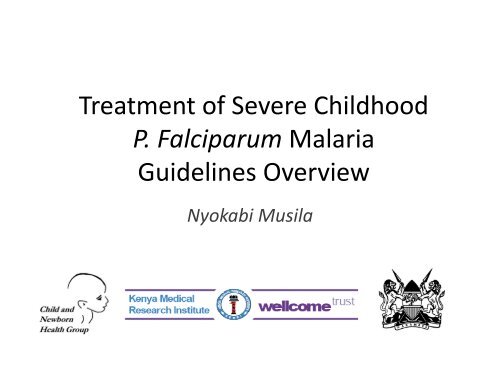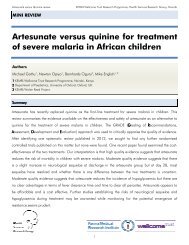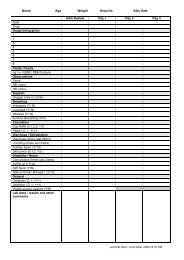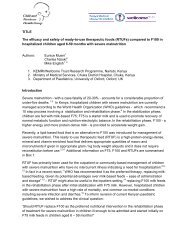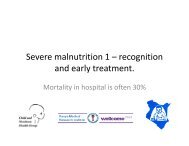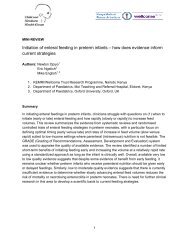Treatment of Severe Childhood P. Falciparum Malaria ... - iDOC Africa
Treatment of Severe Childhood P. Falciparum Malaria ... - iDOC Africa
Treatment of Severe Childhood P. Falciparum Malaria ... - iDOC Africa
You also want an ePaper? Increase the reach of your titles
YUMPU automatically turns print PDFs into web optimized ePapers that Google loves.
<strong>Treatment</strong> <strong>of</strong> <strong>Severe</strong> <strong>Childhood</strong>P. <strong>Falciparum</strong> <strong>Malaria</strong>Guidelines OverviewNyokabi Musila
Outline• Definition <strong>of</strong> severe malaria in <strong>Africa</strong>n children• Evidence reviews on treatment <strong>of</strong> severechildhood malaria• National and global guidance• <strong>Treatment</strong> <strong>of</strong> severe childhood malaria• <strong>Treatment</strong> <strong>of</strong> uncomplicated childhood malaria• Questions• Summary
Endemicity <strong>of</strong> childhood malaria in 2009
Why is endemicity important?In a recent study <strong>of</strong> ~4,500 children admitted tohospitals in northern Tanzania all with a diagnosis<strong>of</strong> ‘severe malaria’• Only half hlf<strong>of</strong> the 4,500 hd had malaria on a bloodslide• Only 1 in 5 children aged 1200m, a low risk malaria area, hadmalaria on a blood slide• Death was much more common in those• Death was much more common in thosefalsely diagnosed as malaria
Criteria useful for defining severe malaria in <strong>Africa</strong>nchildren in endemic areasCerebral <strong>Malaria</strong>Convulsions<strong>Severe</strong> anaemiaAcute renal failureXHypoglycaemiaShock ?Pulmonary oedemaXBleedingHyperpyrexiaXHyperparasitaemiaHaematuria ?XXXPlus….Respiratory distress
Other forms <strong>of</strong> severe malaria……in endemicareasAcute renalfailurePulmonaryoedemaBleedingHyperpyrexia,Temp >42 0 C• These are either souncommon in malaria, or notcaused by malaria at all inchildren in endemic areas,that you should assumeanother cause or disease ispresent.• Assuming these are caused bymalaria is very dangerous.
Life‐threatening malariaComa‘3’ group ‘2’ group ‘1’ groupRespiratorydistressHypoglycaemiayInability to sitor drink<strong>Severe</strong>anaemiaMultipleconvulsions1 convulsionHightemperatureHigh risk <strong>of</strong>deathSome risk <strong>of</strong>deathVery Low risk<strong>of</strong> death
Life‐threatening malariaComa‘3’ group ‘2’ group ‘1’ groupRespiratorydistressHypoglycaemiaInability to sitor drink<strong>Severe</strong>anaemiaMultipleconvulsions1 convulsionHightemperatureRespiratory distress & <strong>Severe</strong> Anaemia,3 x 2 = Very high h risk <strong>of</strong> death
Life‐threatening malaria‘3’ groupComaRespiratorydistressHypoglycaemia‘2’ groupInability to sitor drink<strong>Severe</strong>anaemiaMultipleconvulsions‘1’ group1 convulsionHightemperature1 convulsion & hightemperature,1 x 1 = Very low risk <strong>of</strong> death
Diagnosing childhood severe malariaComain endemic areas‘3’ group ‘2’ group ‘1’ groupRespiratorydistressHypoglycaemiayInability to sitor drink<strong>Severe</strong>anaemiaMultipleconvulsions1 convulsionHightemperature+ confirmation with+ confirmation withmicroscopy or RDTmicroscopy or RDTLife threatening:requires parenteral txNOT life threatening:manage with oral tx
<strong>Treatment</strong> <strong>of</strong> severe childhoodmalaria
<strong>Treatment</strong> <strong>of</strong> childrenwith severe malaria• <strong>Severe</strong> malaria is a medical emergency• Primary treatment objective is prevention <strong>of</strong>death• Secondary treatment objective is prevention <strong>of</strong>disabilities and recrudescence• Chloroquine and sulphadoxine‐pyrethamine (SP)are NOT recommended• 2 classes <strong>of</strong> drugs: cinchona alkaloids (quinineand quinidine) and artemisinin derivatives
GoK GuidanceMinistry <strong>of</strong> HealthBasic Paediatric Protocols (2005)Republic <strong>of</strong> Kenya.Paediatric Protocols for District Hospitals.December 2005UPDATEBasic Paediatric Protocols (2010)National Guidelines for theDiagnosis, <strong>Treatment</strong> andPrevention <strong>of</strong> <strong>Malaria</strong> inKenya (2010)
WHO GuidanceGlobal recommendations on thecase management <strong>of</strong> malariaGRADE tool used only for newevidence <strong>of</strong> 2010 updateFramework for policy‐makers tomake more country‐specifictreatment protocols that take intoaccount local resistance patterns& health service capacity
WHO 2010: Pre‐referral treatment <strong>of</strong>severe childhood malaria• Rectal Artesunate 10 mg/kg*OR• IM Quinine loading dose 20 mg/kgOR• IM Artesunate 24mg/kg 2.4mg/kgOR• IM Artemether 32mg/kg 3.2 loading dose*Based on 2 <strong>Africa</strong>n studies that show pre referral rectal artesunate*Based on 2 <strong>Africa</strong>n studies that show pre‐referral rectal artesunate10mg/kg reduces the risk <strong>of</strong> death and permanent disability in childrenunder 5
GoK 2010: Pre‐referral treatment <strong>of</strong>severe childhood malariaFirst‐lineIM quinine loading dose 20 mg/kg (salt)Second‐line (in absence <strong>of</strong> quinine)• Rectal artesunate 10 mg/kgOR• IM Artesunate 2.4mg/kgOR• IM Artemether 3.2 mg/kg loading doseCheck in hospitals to avoid double loading
Primary EvidenceQuinine vs. Artemisininsderivatives
Evidence for treatment <strong>of</strong> severe malariain children with quinine – EfficacyWhat is the effectiveness <strong>of</strong> quinine compared toartemisinin derivatives in the treatment <strong>of</strong> severemalaria in <strong>Africa</strong>n children?
POPULATION INTERVENTION CONTROL OUTCOMEChildren /newbornsQuinineArtemisininderivatives1° outcome• Mortality2° outcomes• Clinicalcuranceindicators• AdverseeventsSample size(N)IVQuinineIMartemisininderivative1258 Quinine Artemether194 Quinine β ‐Arteether72 Quinine Artesunate
Evidence SummaryQuinine vs Artemisinins for severemalaria in childrenEquivocal in• risk <strong>of</strong> death• parasite clearance time• fever clearance time• coma resolution time• incidence <strong>of</strong> neurological sequelae• 28 th day cure rateStrength <strong>of</strong>evidenceModerateto lowquality
<strong>Africa</strong> Quinine versus Artesunate in <strong>Severe</strong>Ml <strong>Malaria</strong> Trial Ti l(AQUAMAT)• Multi‐centre trial in 9 <strong>Africa</strong>n countries• Target number <strong>of</strong> children: 5,300 patients• Anticipated end date: 31 st December 2010.
Primary EvidenceQuinineiLoading dosevs.No loading dose
Principle <strong>of</strong> quinine loading dose fortreatment <strong>of</strong> severe malariaQuin nine lev vel in bo odyTime spent withinadequate levelwithout loading doseWith loading doseLevel requiredto kill parasitesWithout loading dose0 12Days after treatment
Evidence for treatment <strong>of</strong> severe malariain children with quinine – Loading doseWhat is the effectiveness <strong>of</strong> quinine when givenwith a loading dose compared to when givenwithout a loading dose in the treatment <strong>of</strong> severemalaria in <strong>Africa</strong>n children?
POPULATION INTERVENTION CONTROL OUTCOMEChildren /newbornsQuinine loadingdose thenmaintenancedoseNo loadingdose –uniform dose1° outcome• Mortality• Clinical curanceindicators2° outcomes• Adverse events4 <strong>Africa</strong>n studies, n=144
Evidence summaryQuinine i loading dose vs. no loading doseLoading dose effect• Faster fever clearance• Faster parasite clearance• Increased risk <strong>of</strong> transient hearing lossStrength<strong>of</strong>evidenceModeratequality
Evidence summaryQuinine loading dose vs. no loading doseNo difference in effect onStrength <strong>of</strong>evidence• Risk <strong>of</strong> death• Number <strong>of</strong> convulsions• Coma recovery timeLow to• Number with asexual parasitaemia moderateafter 24 and 48 hoursquality• Neurological sequalae• Dose‐related adverse events
<strong>Malaria</strong> <strong>Treatment</strong> Guidelines<strong>Severe</strong> childhood malaria
WHO Guidance: First‐line treatment for severechildhood malariaQuinine 20 mg/kg g (salt) loadingdose as IV infusion or divided IMinjection then 10 mg/kg g every 8hoursORArtesunate 24mg/kg 2.4 IV or IMthen at 12 hours and 24 hoursthen once daily
GoK Guidance: First‐line treatment for severechildhood malariaMinistry <strong>of</strong> HealthRepublic <strong>of</strong> Kenya.Paediatric Protocols for District Hospitals.December 20052005Quinine 15mg/kg (salt) loading doseas IV infusion i or IM injectionithen maintenance with 10 mg/kg(salt) every 12 hours until patient cantolerate oral treatment2010Quinine 20 mg/kg (salt) loading doseas IV infusion or IM injectionthen 10 mg/kg (salt) every 8 hoursuntil patient t can tolerate t oraltreatmentNEW
Quinine dosing GoK guidance2005 vs 2010• There are no efficacy studies with head‐to‐headcomparisons <strong>of</strong> the 2 dosing regimens:LD 15 mg/kg then 10 mg/kg bd(GoK 2005 regimen)vs.LD 20 mg/kg then 10 mg/kg tds(WHO 2010 / GoK 2010 regimen)• Main concern is quinine toxicity• Estimated therapeutic range <strong>of</strong> unbound quinine forKenyan strains <strong>of</strong> P <strong>Falciparum</strong> is 0.2 to 2.0 mg/l(Winstanley 1994)
WHO 2010: Second‐line treatment for severe malariaIf quinine and artesunate are notavailable, giveArtemether 3.2 mg/kg IMthen 1.6 mg/kg IM per day
GoK 2010: Second‐line treatment forsevere malariaArtesunate 24mg/kg 2.4 IV or IM loadingdosethen 1.2 mg/kg at 12 hours and 24 hoursthen once dailyORArtemether 3.2 mg/kg IM loading dosethen 1.6 mg/kg once dailyNEW
Follow‐on oral treatment forsevere childhood malaria
GoK Guidance : Follow‐on oral treatmentMinistry <strong>of</strong> Health2005 and 2010Republic <strong>of</strong> Kenya. • 1 st line:Full course <strong>of</strong> Artemetherplus lumefantrine (AL)Paediatric Protocols for District Hospitals.December 2005• 2 nd line (if AL is unavailable):Quinine every 8 hours tocomplete lt a course <strong>of</strong> 7 daysparenteral and oral treatment
WHO 2010: Follow‐on oral treatmentAfter parenteral antimalarial for aminimum <strong>of</strong> 24 hours, give one <strong>of</strong>the following:• Artermether plus lumefantrine (AL)• Artesunate plus amodiaquine• Dihydroartemisinin plus piperaquine pp • Artesunate plus sulphadoxinepyrethamine(SP)• Artesunate plus Clindamycin• Quinine plus Clindamycin orDoxycycline
<strong>Treatment</strong> <strong>of</strong> uncomplicatedchildhood malaria
WHO 2010: <strong>Treatment</strong> <strong>of</strong> uncomplicatedmalaria in childrenFirst‐lineOral ACTsGRADE: Moderate quality evidenceStrong recommendation
GoK 2010: <strong>Treatment</strong> <strong>of</strong> uncomplicatedmalaria in childrenRequires positive RDT/microscopy diagnosisAim: Cure <strong>of</strong> the diseaseFirst‐lineArtemether plus Lumefantrine (AL)Second line (if treatment failure)Dihydroartemisinin plus Piperaquine<strong>Treatment</strong> failure is defined as the failure to achievethe desired therapeutic response after the initiation<strong>of</strong> therapy
Differences between new GoK and WHOguidelines on treatment <strong>of</strong> severe childhoodmalariaGoK (2010) WHO (2010)• Quinine is first‐linetreatment• Limited it oral follow‐uptreatments to quinine or AL• Artesunate is interchangablewith quinine• Artemether is recommended2 nd line only if quinine andartesunate are unavailable• Specifies 24 hours minimumiparenteral treatment
Questions ?
Summary – diagnosis <strong>of</strong> childhoodsevere malaria• In malaria endemic areas severe malaria hasbeen re‐defined as one or a combination <strong>of</strong>:– Coma & neurological impairment– Respiratory distress– Hypoglycaemia– <strong>Severe</strong> anaemia• If a child has more than one feature <strong>of</strong> severemalaria it is a medical emergency.
Summary –treatment <strong>of</strong> childhoodsevere malaria• New imminent i tGoK K(2010) guidelines haveadopted:– WHO dosing recommendations for IMquinine 20mg/kg then 10mg/kg tds• Need to look at Kenyan/<strong>Africa</strong>n evidence‐baseto inform treatment <strong>of</strong> severe malaria inKenyan children


